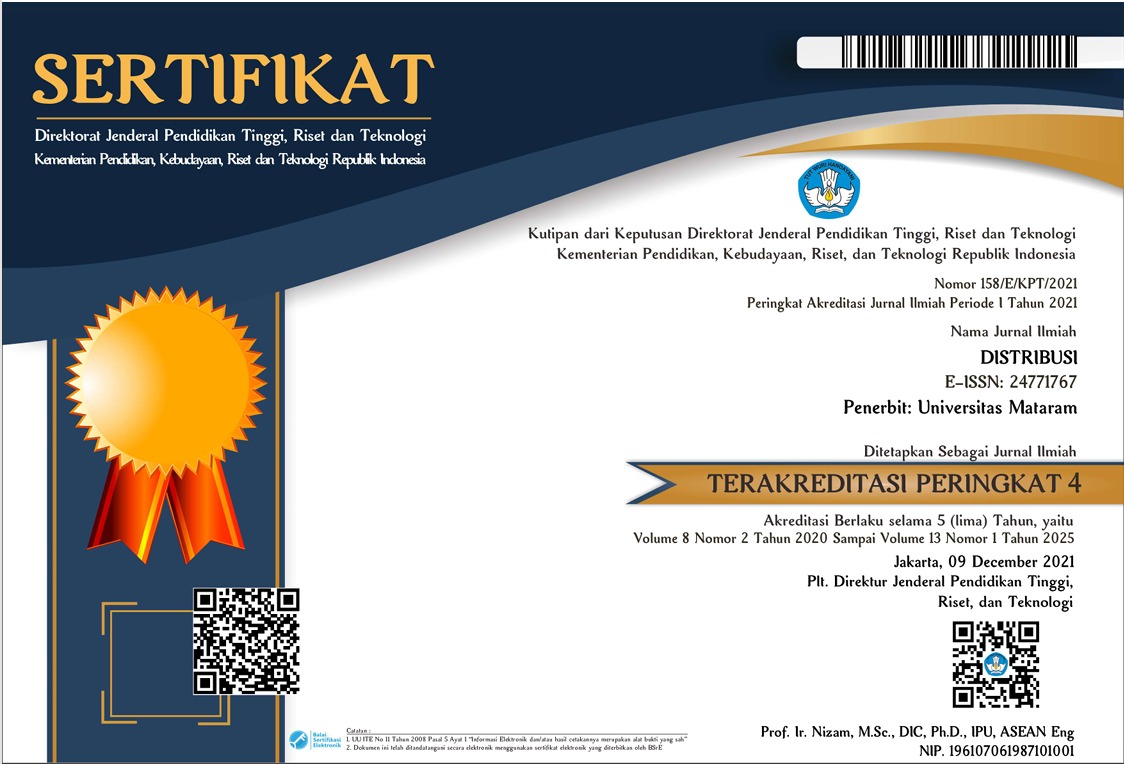TELAAH KONSEPTUAL RELATIONSHIP MARKETING DAN PERKEMBANGANNYA
DOI:
https://doi.org/10.29303/distribusi.v7i1.56Keywords:
relationship marketing, marketing philosophy, resources based, marketing strategy, value creation, value co-creationAbstract
Many academics and practician of marketing admit that Relationship Marketing (RM) has developed vastly and also considered contributed to paradigm reformation, it even become the basis of marketing science theory reform. Hence, discussion on RM is interesting to be studied. The study aimed to synthesize various opinion and former research result to get a clearer view for academics, manager and general reader concerning concept of RM. Various literatures, either periodic journals, conference articles and textbooks are collected and used as references in this monography. Writer find out some perspectives used by scientists to describe RM concept, start from marketing philosopny aspect, resources based perspective, marketing strategy, value creation and mutual value creation (value co-creation). Writer concluded that various perspectives applied in formulating RM is strengthen the other perspective. Despite seems to be overlapped but there’s a link that connected each perspective. Writer thought that (theoretically) value co-creation is the most relevant perspective to outlines RM process and activities in today’s situation. Whereas in field, many corporates placed RM as one of their main strategy in marketed the company.Downloads
References
Bendapudi, N., & Leone, R. P. (2003). Psychological Implications of Customer Partici-pation in Co-Production. Journal of Marketing, 67(1), 14–28. https://doi.org/10.1509/jmkg.67.1.14.18592
Berry, L. L. (2002). Relationship Marketing of Services Perspectives from 1983 and 2000. Journal of Relationship Marketing, 1(1), 59–77. https://doi.org/10.1300/J366v01n01_05
Bhalla, G. (2011). Collaboration and Co-creation: New Platforms for Marketing and Innovation (1st ed.). Springer-Verlag New York.
Blois, K. J. (1996). Relationship marketing in organizational markets: When is it appro-priate? Journal of Marketing Management, 12(1–3), 161–173. https://doi.org/10.1080/0267257X.1996.9964406
Bröring, S., & Cloutier, D. (2008). Value-creation in new product development within converging value chains: An analysis in the functional foods and nutraceutical industry. British Food Journal, 110(1), 76–97. https://doi.org/10.1108/00070700810844803
Cambra-Fierro, J., Melero-Polo, I., & Sese, F. J. (2018). Customer value co-creation over the relationship life cycle. Journal of Service Theory and Practice, 28(3), 336–355. https://doi.org/10.1108/JSTP-01-2017-0009
Carbonell, P., Rodríguez‐Escudero, A. I., & Pujari, D. (2009). Customer Involvement in New Service Development: An Examination of Antecedents and Outcomes*. Journal of Product Innovation Management, 26(5), 536–550. https://doi.org/10.1111/j.1540-5885.2009.00679.x
Christopher, M., Payne, A., & Ballantyne, D. (1993). Relationship Marketing: Bringing quality, customer service and marketing together. Oxford: Butterworth-Heinemann.
Cravens, D., & Piercy, N. (2012). Strategic Marketing (10 edition). New York: McGraw-Hill Education.
Dwyer, F. R., Schurr, P. H., & Oh, S. (1987). Developing Buyer-Seller Relationships. Journal of Marketing, 51(2), 11–27. https://doi.org/10.2307/1251126
Egan, J. (2011). Relationship Marketing: Exploring Relational Strategies in Marketing. Financial Times, Prentice Hall.
Erdélyi, P., Ngugi, I. K., & Johnsen, R. E. (2010). Relational capabilities for value co‐creation and innovation in SMEs. Journal of Small Business and Enterprise Development, 17(2), 260–278. https://doi.org/10.1108/14626001011041256
Forsström, B. (2005). Value co-creation in industrial buyer-seller partnerships - creating and exploiting interdependencies : an empirical case study. Retrieved from http://www.doria.fi/handle/10024/4144
Foster, B. (2008). Manajemen Ritel. Bandung: Alfabeta.
Gronroos, C. (1990). Service Management and Marketing: Managing the Moment of Truth in Service Competition. Lexington, Mass: Lexington Books.
Grönroos, C. (1994). From Marketing Mix to Relationship Marketing: Towards a Para-digm Shift in Marketing. Management Decision, 32(2), 4–20. https://doi.org/10.1108/00251749410054774
Grönroos, C. (1996). Relationship marketing: strategic and tactical implications. Man-agement Decision, 34(3), 5–14. https://doi.org/10.1108/00251749610113613
Grönroos, C. (1997). Value‐driven relational marketing: From products to resources and competencies. Journal of Marketing Management, 13(5), 407–419. https://doi.org/10.1080/0267257X.1997.9964482
Grönroos, C. (2000). Creating a Relationship Dialogue: Communication, Interaction and Value. The Marketing Review, 1(1), 5–14. https://doi.org/10.1362/1469347002523428
Grönroos, C. (2008). Service logic revisited: who creates value? And who co‐creates? European Business Review, 20(4), 298–314. https://doi.org/10.1108/09555340810886585
Grönroos, C. (2017). Relationship marketing and service: An update. Journal of Global Scholars of Marketing Science, 27(3), 201–208. https://doi.org/10.1080/21639159.2017.1318666
Gummesson, E. (2008). Total Relationship Marketing, Third Edition: Marketing man-agement, relationship strategy,CRM, and a new dominant logic for the value-creating network economy (3 edition). London: Butterworth-Heinemann.
Harmeling, C. M., Kumar, V., & Palmatier, R. W. (2018). Customer engagement mar-keting. Palgrave Macmillan.
Hunt, S. D. (2010). Marketing Theory: Foundations, Controversy, Strategy, and Re-source-advantage Theory. Routledge.
Kotler, P., & Armstrong, G. (2018). Principles of Marketing. Pearson.
Kotler, P., & Keller, K. L. (2016). A Framework for Marketing Management (6th, Global Edition). Pearson.
Madhavaram, S., Arnett, D. B., & Hunt, S. D. (2006). The explanatory foundations of relationship marketing theory. Journal of Business & Industrial Marketing, 21(2), 72–87. https://doi.org/10.1108/10610420610651296
Morgan, R. M., & Hunt, S. D. (1999). Relationship-Based Competitive Advantage: The Role of Relationship Marketing in Marketing Strategy. Journal of Business Re-search, 46(3), 281–290. https://doi.org/10.1016/S0148-2963(98)00035-6
Morgan, R. M., & Hunt, S. D. (1994). The Commitment-Trust Theory of Relationship Marketing. Journal of Marketing, 58(3), 20–38. https://doi.org/10.2307/1252308
Normann, R., & Ramírez, R. (1993). From value chain to value constellation: designing interactive strategy. Harvard Business Review, 71(4), 65–77.
OHern, M. S., & Rindfleisch, A. (2010). Customer Co-Creation. In N. K. Malhotra (Ed.), Review of Marketing Research (Vol. 6, pp. 84–106). Emerald Group Pub-lishing Limited. https://doi.org/10.1108/S1548-6435(2009)0000006008
Palmatier, R. W. (2008). Relationship Marketing. Cambridge, Mass: Marketing Science Institute.
Palmatier, R. W., Jarvis, C. B., Bechkoff, J. R., & Kardes, F. R. (2009). The Role of Customer Gratitude in Relationship Marketing. Journal of Marketing, 73(5), 1–18. https://doi.org/10.1509/jmkg.73.5.1
Palmatier, R. W., Kumar, V., & Harmeling, M. C. (Eds.). (2018). Customer engagement marketing. Palgrave Macmillan.
Palmer, A. J. (1995). Relationship marketing: Local implementation of a universal con-cept. International Business Review, 4(4), 471–481. https://doi.org/10.1016/0969-5931(95)00027-5
Palmer, A. J., & Koenig-Lewis, N. (2009). An entended, community focused, experien-tial framework for relationship marketing. Journal of Customer Behaviour, 8(1), 85–96. https://doi.org/10.1362/147539209X414407
Petrof, J. V. (1997). Relationship marketing: the wheel reinvented? Business Horizons, 40(6), 26–31. https://doi.org/10.1016/S0007-6813(97)90064-1
Prahalad, C. K., & Ramaswamy, V. (2004). The Future of Competition: Co-Creating Unique Value with Customers. Harvard Business School Press. Retrieved from https://hbr.org/product/the-future-of-competition-co-creating-unique-value-with-customers/9535E-KND-ENG
Qi, L., Wang, K., Wang, X., & Zhang, F. (2010). Research On The Relationship Among Market Orientation, Customer Relationship Management, Customer Knowledge Management And Business Performance. Management Science and Engineering, 2(1), 32–38. https://doi.org/10.3968/j.mse.1913035X20080201.004
Ramaswamy, V. (2008). Co‐creating value through customers’ experiences: the Nike case. Strategy & Leadership, 36(5), 9–14. https://doi.org/10.1108/10878570810902068
Rashid, T. (2003). Relationship marketing: case studies of personal experiences of eating out. British Food Journal, 105(10), 742–750. https://doi.org/10.1108/00070700310506281
Ravald, A., & Grönroos, C. (1996). The value concept and relationship marketing. Eu-ropean Journal of Marketing, 30(2), 19–30. https://doi.org/10.1108/03090569610106626
Rich, M. K. (1999). Business Market Management:: Understanding, Creating, and Deli-vering Value. Journal of Business & Industrial Marketing, 14(3), 76–80. https://doi.org/10.1108/jbim.1999.14.3.76.1
Ritter, T., & Gemuenden, H. (2003). Interorganizational relationships and networks: An overview. Journal of Business Research, 56, 691–697. https://doi.org/10.1016/S0148-2963(01)00254-5
Sacui, V., & Dumitru, F. (2014). Market-based Assets. Building Value through Market-ing Investments. Procedia - Social and Behavioral Sciences, 124, 157–164. https://doi.org/10.1016/j.sbspro.2014.02.472
Sharafizad, J., & Standing, C. (2017). Determinants of relationship marketing by women small business owners. Journal of Small Business & Entrepreneurship, 29(4), 271–291. https://doi.org/10.1080/08276331.2017.1325267
Sharma, A., Tzokas, N., Saren, M., & Kyziridis, P. (1999). Antecedents and Conse-quences of Relationship Marketing: Insights from Business Service Salespeople. Industrial Marketing Management, 28, 601–611.
Sheth, J. N., & Parvatiyar, A. (1992). Towards a theory of business alliance formation. Scandinavian International Business Review, 1(3), 71–87. https://doi.org/10.1016/0962-9262(92)90012-U
Sheth, J. N., & Parvatiyar, A. (1995). The evolution of relationship marketing. Interna-tional Business Review, 4(4), 397–418. https://doi.org/10.1016/0969-5931(95)00018-6
Sirdeshmukh, D., Singh, J., & Sabol, B. (2002). Consumer Trust, Value, and Loyalty in Relational Exchanges. Journal of Marketing, 66(1), 15–37. https://doi.org/10.1509/jmkg.66.1.15.18449
Smirnova, M., & P. Kushch, S. (2006). Understanding the Role of Relational Capabili-ties in Buyer-Seller Relationships.
Smith, J. B. (1998). Buyer–Seller relationships: Similarity, relationship management, and quality. Psychology & Marketing, 15(1), 3–21. https://doi.org/10.1002/(SICI)1520-6793(199801)15:1<3::AID-MAR2>3.0.CO;2-I
Smith, M. (2011). The New Relationship Marketing: How to Build a Large, Loyal, Prof-itable Network Using the Social Web. Wiley.
Srivastava, R. K., Shervani, T. A., & Fahey, L. (1998). Market-Based Assets and Shareholder Value: A Framework for Analysis. Journal of Marketing, 62(1), 2–18. https://doi.org/10.2307/1251799
Sulhaini, S. (2014). Relationship Marketing. Mataram: UPT. Mataram University Press.
Takala, T., & Uusitalo, O. (1996). An alternative view of relationship marketing: A framework for ethical analysis. European Journal of Marketing - EUR J MARK, 30, 45–60. https://doi.org/10.1108/03090569610106644
Vargo, S. L., & Lusch, R. F. (2010). “Relationship” in Transition: An Introduction to the Special Issue on Relationship and Service-Dominant Logic. Journal of Busi-ness Market Management, 4(4), 167–168. https://doi.org/10.1007/s12087-010-0042-4
Wehrli, H. P., & Jüttner, U. (1994). Relationship Marketing from a Value System Pers-pective. International Journal of Service Industry Management, 5(5), 54–73. https://doi.org/10.1108/09564239410074394
Zhang, J. Z., Watson, G. F., Palmatier, R. W., & Dant, R. P. (2016). Dynamic Relation-ship Marketing. Journal of Marketing, 80(5), 53–75. https://doi.org/10.1509/jm.15.0066
Downloads
Published
How to Cite
Issue
Section
License
Penulis yang naskahnya diterbitkan menyetujui ketentuan sebagai berikut:
- Hak publikasi atas semua materi naskah jurnal yang diterbitkan/dipublikasikan dalam situs Jurnal DISTRIBUSI ini dipegang oleh dewan redaksi dengan sepengetahuan penulis (hak moral tetap milik penulis naskah).
- Ketentuan legal formal untuk akses artikel digital jurnal elektronik ini tunduk pada ketentuan lisensi Creative Commons Attribution-ShareAlike (CC BY-SA), yang berarti Jurnal DISTRIBUSI berhak menyimpan, mengalih media/format-kan, mengelola dalam bentuk pangkalan data (database), merawat, dan mempublikasikan artikel tanpa meminta izin dari Penulis selama tetap mencantumkan nama Penulis sebagai pemilik Hak Cipta.
- Naskah yang diterbitkan/dipublikasikan secara cetak dan elektronik bersifat open access untuk tujuan pendidikan, penelitian, dan perpustakaan. Selain tujuan tersebut, dewan redaksi tidak bertanggung jawab atas pelanggaran terhadap hukum hak cipta.









